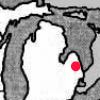
| Mav - 3/28/2025 19:55
That inflation chart is simply the maximum pressure for each size of tire that may be on the machine ... basically the maximum pressure/load printed on the side of a tire.
I absolutely refuse to run that much pressure in the main frame 11L-15 F1's that are on our 32.5' TM200 ... they are actually around the 45-psi mark. If I go much above that, the wheels want to "sink and plow" in softer ground. The other problem with running maximum air pressure in a tire that has a lighter load on it, is that the weight gets concentrated onto a smaller tire footprint. That in turn, drastically shortens tire life. BUT I will also say that we are fortunate in the aspect that most of our ground is relatively close together. Therefore, the road travel is rather minimal and almost exclusively gravel ... AND we are not carrying as much weight as a larger machine. But I will brag a little because we are currently still running on three of the original infamously junk Carlisle tires, which are going well on 15 years of service now. They are definitely not pristine by any means, but they still look like they have an adequate amount of life left in them.
So pretty much, this is what I am trying to say. Over the course of many years, I think I have developed a good sense as to how much "squat" a tire should have. I then take that gut feeling and usually check it against a load/inflation chart from a reliable manufacturer just to make sure that I am not completely out of line. More times than not, my gut and the load chart come out to something that is much lower than what is printed on the sidewall. On a typical 15" implement tire, I would probably shoot for an inflation pressure that gives around 6" of tire footprint length.
Mav
A 50 ' machine I would think the tires would be heavy duty
and take way more the 45 # if running a lot of road time |


 Tire Pressures on Tigermate 200
Tire Pressures on Tigermate 200